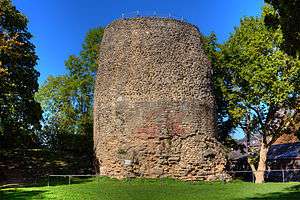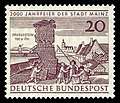Drususstein
The Drususstein (Drusus stone) is a nearly 20 metres high masonry block of Roman origin on the grounds of the citadel of Mainz, Germany. It was originally cased in marble. Researchers now largely accept that this is the structural remnant of the cenotaph mentioned by writers like Eutropius and Suetonius,[1] erected in 9 BC by Roman troops in honour of the deceased general Drusus,[2] in Mogontiacum (now Mainz) as part of the Roman funerary art.

During the early days of the Principate the Drususstein was the starting point for elaborate memorial services in honour of Drusus, and the centre of the imperial cult in Mogontiacum. A procession road linked it to the public theater of Mogontiacum that had about 12,000 seats, making it the largest known theater north of the Alps. It may have hosted a part of the annual ceremonies at the day of Drusus' death, and probably also at his birthday.[3]
After being robbed of its marble casing in the early Middle Ages, the Drususstein served as a watchtower in the fortifications of the city in the 16th century. For that purpose a staircase and doorframe were made in the structure, which had been up to that point a massive building. Besides the pillars of aqueducts and the stage of the theatre, the Drususstein is one of the few remaining visible reminders of Roman Mogontiacum. Together with the Igel Column, it is the only funerary monument north of the Alps dating from antiquity that remains in its original location.[4]
Historical background
The Roman general Drusus, stepson of Augustus, founded the legionary camp of Mogontiacum opposite the mouth of the Main, no later than 13/12 BC. It was intended to serve as a strategic starting point for the conquest of Magna Germania.[5] During the campaign in 9 BC Drusus died. His brother Tiberius and the Roman army returned his body back to Mogontiacum. Before the transfer of the body to Rome, the soldiers honoured their popular commander[6] with a memorial ceremony. During this time the apparently spontaneous wish arose among the soldiers to erect a monument to permanently honour Drusus in Mogontiacum. Appropriate construction activities were probably already ongoing in the immediate vicinity of the legionary camp, as Augustus approved the project retroactively.[7] As a special tribute to Drusus, Augustus himself wrote a grave inscription (Elogium) which was attached to the cenotaph. With this the building was completed, of which the remains are now known as the Drususstein.
Fictional references
The ceremonies at the Drususstein feature as a major plot element in volume 2 of the novel series Romanike.[8]
 Image by Johann Huttich (Woodcut, between 1512/13 and 1517)
Image by Johann Huttich (Woodcut, between 1512/13 and 1517) Image in Matthäus Merian's Topographia Germaniae (Engraving, 1646)
Image in Matthäus Merian's Topographia Germaniae (Engraving, 1646) Early photograph of the Drususstein (1892 or 1895/96)
Early photograph of the Drususstein (1892 or 1895/96) Postage Stamp by the Deutsche Bundespost (1962): 2000 year Celebrations of the City of Mainz
Postage Stamp by the Deutsche Bundespost (1962): 2000 year Celebrations of the City of Mainz
Literature
- Bellen, Heinz (1997). Schumacher, Leonhard (ed.). Das Drususdenkmal apud Mogontiacum und die Galliarum civitas [Politik-Recht-Gesellschaft. Studien zur Alten Geschichte]. Historia Einzelschriften (in German). 115. p. 85 ff.
- Decker, Karl-Viktor; Selzer, Wolfgang (1976). Temporini, Hildegard; Haase, Wolfgang (eds.). Mainz von der Zeit des Augustus bis zum Ende der römischen Herrschaft. [Aufstieg und Niedergang der römischen Welt: Geschichte und Kultur Roms im Spiegel der neueren Forschung.] (in German). II.5.1. Berlin: Walter de Gruyter. pp. 457–559. ISBN 3-11-006690-4.
- Frenz, Hans. G. (1985). Drusus maior und sein Monument zu Mainz. [Jahrbuch des Römisch-Germanischen Zentralmuseums Mainz] (in German). 32. pp. 394–421.
- Panter, Andreas (2007). Der Drususstein in Mainz und dessen Einordnung in die römische Grabarchitektur seiner Erbauungszeit. [Mainzer Archäologische Schriften] (in German). 6. Mainz: Archäologische Denkmalpflege Amt Mainz. ISBN 978-3-935970-03-7.
- Pelgen, Franz Stephan (2003). Mainz. Vom "elenden Steinklumpen" zum Denkmal. Aus der Geschichte der Mainzer Römerruinen (in German). Mainz: Philipp von Zabern. ISBN 3-8053-3283-1.
- Selzer, Wolfgang; Karl-Victor Decker; Anibal Do Paco (1988). Römische Steindenkmäler. Mainz in römischer Zeit (in German). Mainz: Philipp von Zabern. ISBN 3-8053-0993-7.
- Spickermann, Wolfgang (2006). Cancik, Hubert; Schäfer, Alfred; Spickermann, Wolfgang (eds.). Mogontiacum (Mainz) als politischer und religiöser Zentralort der Germania superior. ['Zentralität und Religion]. Studien und Texte zu Antike und Christentum (in German). 39. Tübingen: Mohr Siebeck. ISBN 3-16-149155-6.
References
- Eutropius Breviarium ab urbe condita, 7, 12-13; Sueton: Claudius, 1.3; 11,2
- Jürgen Oldenstein: Mogontiacum. In: Heinrich Beck, Dieter Geuenich and Heiko Steuer (Eds.): Reallexikon der Germanischen Altertumskunde. Band 20: Metuonis – Naturwissenschaftliche Methoden in der Archäologie. S. 147; Heinz Cüppers: Die Römer in Rheinland-Pfalz. p. 463; Andreas Panter: Der Drususstein in Mainz und dessen Einordnung in die römische Grabarchitektur seiner Erbauungszeit. p. 102.
- Schmid, A., Schmid, R., Möhn, A., Die Römer an Rhein und Main (Frankfurt: Societäts-Verlag, revised edition 2006).
- Heinz Cüppers: Die Römer in Rheinland-Pfalz., p. 463
- Marion Witteyer: Mogontiacum – Militärbasis und Verwaltungszentrum. Der archäologische Befund. In Franz Dumont (Eds.), Ferdinand Scherf and Friedrich Schütz: Mainz – Die Geschichte der Stadt. p. 1026.
- Hans G. Frenz: Drusus maior und sein Monument in Mainz. p 394. Frenz führt diese Charakterisierung auf das antike Wahrnehmungsbild des Drusus bei Velleius Paterculus 2, 97, 2-4 und Tacitus: Annalen 2,41; 6,51 zurück.
- For a detailed account: Heinz Bellen: Das Drususdenkmal apud Mogontiacum und die Galliarum civitas. Korrektur-Nachtrag p. 96 ff. und insbesondere p. 98.
- The Romanike series, Codex Regius (2006-2014) Archived 2016-08-06 at the Wayback Machine
External links
| Wikimedia Commons has media related to Drususstein (Mainz). |
- Roman Mainz Initiative with information on the Drususstein (in German)
- Archeological Directorate Mainz – Drususstein (in German)